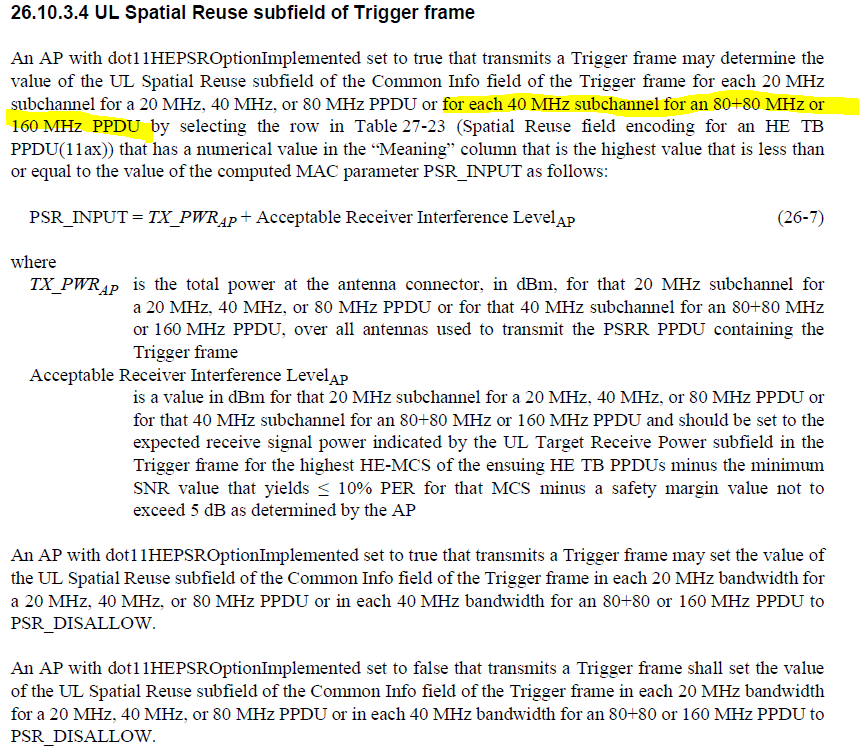Hi, Zinan.
Thank you very much for the document.
|
The most important thing is to be clear that the unit of RPL_{PSRR,20MHz} is dBm/20MHz. How one computes it is implementation specific, except that I agree with you that 20 MHz subchannels which are used in both the PSRR and PSRT should
be used. Therefore, my suggestion is
|
|
I still need more time to review your #2.
Regards,
Youhan
From: Zinan Lin <Zinan.Lin@xxxxxxxxxxxxxxxx>
Sent: Monday, May 2, 2022 11:09 AM
To: Youhan Kim <youhank@xxxxxxxxxxxxxxxx>; ross.yujian@xxxxxxxxxx
Cc: STDS-802-11@xxxxxxxxxxxxxxxxx
Subject: FW: 11-22/0652
WARNING:
This email originated from outside of Qualcomm. Please be wary of any links or attachments, and do not enable macros.
Hi Youhan and Ross,
Per the requirement of REVme minutes (11-22/0679r0), I am resending the discussion email to the reflector.
Thanks,
Zinan
From: Zinan Lin
Sent: Friday, April 29, 2022 10:55 AM
To: youhank@xxxxxxxxxxxxxxxx; Yujian (Ross Yu) <ross.yujian@xxxxxxxxxx>
Cc: Rui Yang <Rui.Yang@xxxxxxxxxxxxxxxx>; M Montemurro <montemurro.michael@xxxxxxxxx>
Subject: 11-22/0652
Hi Youhan and Ross,
Thanks for your comments and discussions on 11-22/0652!
Attached please find the updated document. I summarize the resolutions for the comments you made:
- The definition of
 is
updated as follows:
is
updated as follows:
![]() is
the received signal power at the receive antenna connector in the nonpunctured 20 MHz subchannel in dBm. It can be the received signal power at the received antenna connector in at least one nonpunctured 20 MHz subchannel within the overlapping bandwidth of
the PSRR PPDU and the PSRT PPDU, or the received signal power at the received antenna connector in the nonpunctured 20 MHz subchannels within the overlapping bandwidth of the PSRR PPDU and the PSRT PPDU normalized to a 20 MHz subchannel. The identification
of the overlapping bandwidth is implementation dependent.
is
the received signal power at the receive antenna connector in the nonpunctured 20 MHz subchannel in dBm. It can be the received signal power at the received antenna connector in at least one nonpunctured 20 MHz subchannel within the overlapping bandwidth of
the PSRR PPDU and the PSRT PPDU, or the received signal power at the received antenna connector in the nonpunctured 20 MHz subchannels within the overlapping bandwidth of the PSRR PPDU and the PSRT PPDU normalized to a 20 MHz subchannel. The identification
of the overlapping bandwidth is implementation dependent.
- As indicated in 26.10.3.4 (P4242L1, REVme D1.0), UL Spatial Reuse subfield of Trigger frame is defined for each 40 MHz subchannel for an 80+80MHz or 160 MHz PPDU. The Spatial Reuse
subfields of HE-SIG-A field of an HE TB PPDU should follow this definition, i.e., Spatial Reuse value is applied to 40MHz subband of the 160MHz band. Therefore, when the PSRR PPDU is 160MHz, to get PSR for 20 MHz subchannel, it needs to normalize the PSR
value of the UL Spatial Reuse subfield in the Common Info field of the Trigger frame of the PSRR PPDU to 20 MHz subchannel. The NOTE in the 11-22/0652r3 explained this already.

Please let me know your comments.
Thanks,
Zinan
To unsubscribe from the STDS-802-11 list, click the following link: https://listserv.ieee.org/cgi-bin/wa?SUBED1=STDS-802-11&A=1